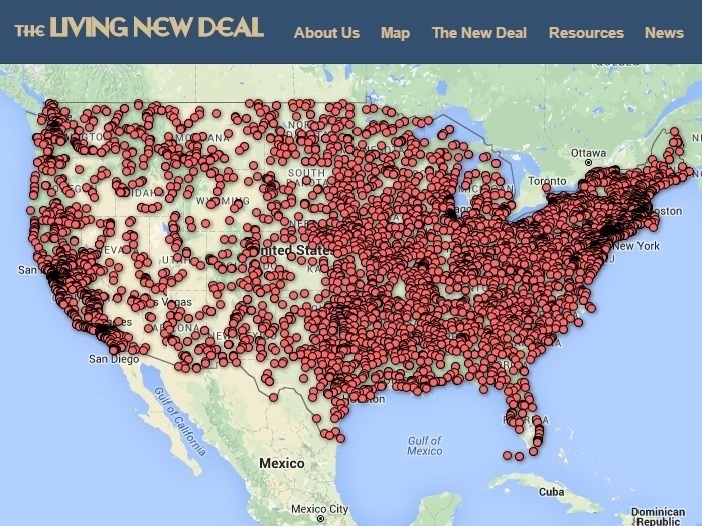The Living New Deal has created a clickable national map to document the many public works projects of the New Deal, which created millions of jobs for unemployed workers. Click on the map image to access the map on the Living New Deal web site, www.LivingNewDeal.org
by Susan Ives
The National Jobs for All Coalition is working with the Living New Deal, a nonprofit organization bringing to light the vast legacy of the New Deal.
FDR’s New Deal created millions of jobs during the Great Depression when a quarter of the work force was out of work. Public investment in such programs as the Works Progress Administration, Public Works Administration, Civilian Conservation Corps, and Federal Art Project, gave America much of its modern infrastructure and spurred a cultural Renaissance. Yet, few people know much about the New Deal or its lasting imprint on the nation.
In 2006 scholars at the University of California’s Geography Department in Berkeley began researching what the New Deal built. That led to a website cataloging nearly 11,000 New Deal sites in all 50 states—schools, libraries, museums, post offices, artworks, parks roads, bridges and more.
A team of volunteers on the lookout for New Deal infrastructure, art, and architecture send their discoveries to the Berkeley team. The information is confirmed and posted to an interactive map that’s linked to descriptions and photographs of each site. A searchable database enables anyone to find out about the New Deal’s contributions to their community and the nation.
The Living New Deal also is promoting the creation of a New Deal museum to showcase the artworks, oral histories, films, photographs and ephemera of the New Deal, and to honor those who led and labored during America’s hardest of hard times.
The Living New Deal has created a “Guide to the Art and Architecture of the New Deal in San Francisco,” and it is currently at work on a guide to the vast number of New Deal sites in New York City.* The National Jobs for All Coalition is planning an event to launch the Living New Deal Project in New York City that will engage a wide range of organizations dedicated to economic justice and environmental sustainability in focusing public attention on persisting real rates of unemployment and underemployment and the benefits of the New Deal job creation model—not only for the unemployed and their families but for the nation’s cultural, environmental, physical, and human service resources.
To learn more and to sign up for the Living New Deal’s newsletter and events, go to http://www.livingnewdeal.org.

